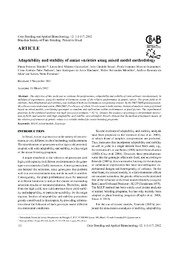Adaptability and stability of maize varieties using mixed model methodology.
Adaptability and stability of maize varieties using mixed model methodology.
Summary: The objective of this study was to evaluate the performance, adaptability and stability of corn cultivars simultaneously in unbalanced experiments, using the method of harmonic means of the relative performance of genetic values. The grain yield of 45 cultivars, including hybrids and varieties, was evaluated in 49 environments in two growing seasons. In the 2007/2008 growing season, 36 cultivars were evaluated and in 2008/2009 25 cultivars, of which 16 were used in both seasons. Statistical analyses were performed based on mixed models, considering genotpes as random and replications within environments as fixed factors. The experimental precision in the combined analyses was high (accuracy estimates > 92 %). Despite the existence of genotype x environment interac-tion, hybrids and varieties with high adaptability and stability were identified. Results showed that the method of harmonic means of the relative performance of genetic values is a suitable method for maize breeding programs.
Publication year: 2012
Types of publication: Journal article
Unit: Embrapa Maize & Sorghum
Observation
Some of Embrapa's publications are published as ePub files. To read them, use or download one of the following free software options to your computer or mobile device. Android: Google Play Books; IOS: iBooks; Windows and Linux: Calibre.
Access other publications
Access the Agricultural Research Database (BDPA) to consult Embrapa's full library collection and records.
Visit Embrapa Bookstore to purchase books and other publications sold by Embrapa.

